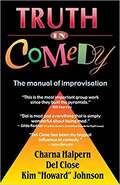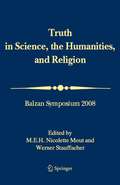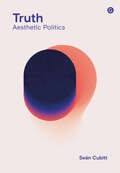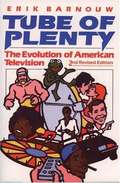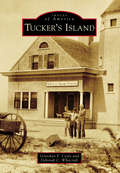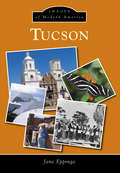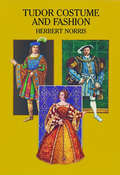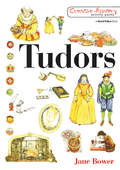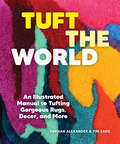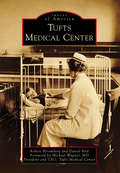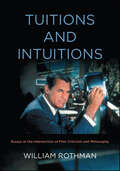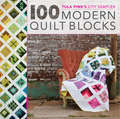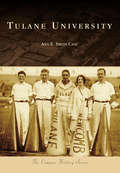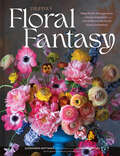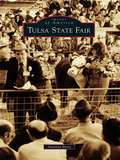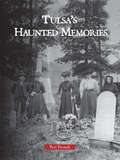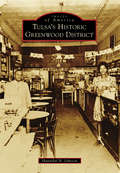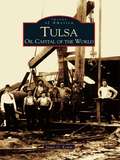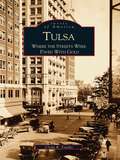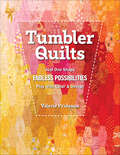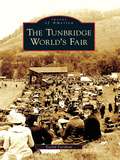- Table View
- List View
Truth in Comedy: The Manual of Improvisation
by Mike Myers Arthur L. Zapel Charna Halpern Del Close Kim H. JohnsonWant to learn the improv techniques that helped Mike Myers, Chris Farley, John Belushi, and many others along the road to TV and film stardom? Then let two esteemed founders of long-form improvisational theatre, Del Close and Charna Halpern, teach you the "Harold." <p><p> This groundbreaking acting exercise emphasizes pattern recognition and subversion of the audience s expectations, which are important factors for making people laugh without ever telling a joke. It involves six to seven players and many kinds of scenes: games, monologues, songs, skits and more, all of which are bound to keep both actors and audience members guessing. <p><p> The Harold is non-linear entertainment that remembers everything and wastes nothing the key to successful improvising and has become a standard in comedy clubs and improv theatres around the globe.
Truth in Science, the Humanities and Religion
by International Balzan FoundationThe question of the meaning of "truth" is central to many areas of contemporary debate, whether between those subscribing to a post-Enlightenment view of the world and those who seek fundamental truth in religious texts, or between those maintaining that there are absolute truths and those believing facts to be social constructs. For some, the ultimate truth is revealed through religious faith and textual authority. Can this view be reconciled with an evidence-based, materialist, post-Enlightenment perspective of the truth as embraced by the natural sciences? If religion holds the key to the truth, which religion and which truths? What is the attitude of the humanities to the meaning of truth? Truth in the sciences and the humanities as well as in religion and theology is the central theme of this book based on the proceedings of a conference organized by the International Balzan Foundation. It contains the speakers' lectures, the corresponding reactions of the invited panel members as well as the general discussions. The reader can familiarize himself with views ranging from philosophy to religion, from mathematics, physics and cosmology to biological sciences, history, sociology and economics. The exceptional wide scope of the book, comprising arguments about truth in the sciences, the humanities as well as religion and theology together with the discussions between representatives of all these different fields, means that it is of interest to a professional as well as a general readership.
Truth or Consequences
by Cindy Carpenter Sherry Fletcher"Hot Springs, New Mexico, Ain't That Any More" was one of the headlines on April 4, 1950, in the Gallup Independent. As a publicity stunt, Ralph Edwards had invited a town to change its name to "Truth or Consequences," the name of his popular radio quiz show, and Hot Springs agreed to do so. Since the late 1800s, the area has attracted health seekers to bathe in and drink from the area's hot mineral springs. The region is home to Elephant Butte Dam and lake, completed in 1916, which remains one of the largest irrigation dams in the United States. Carrie Tingley Crippled Children's Hospital, built in 1937 by New Mexico governor Clyde Tingley, utilized the natural hot mineral waters to treat children with polio. From the placement of the Hot Springs Bathhouse and Commercial District on the State and National Register of Historic Places to the centennial celebration of Elephant Butte Dam, Truth or Consequences continues to grow and develop while still honoring its heritage.
Truth: Aesthetic Politics
by Sean CubittEcologies of truth in a post-truth era.The problem with Neo-Nazis is not that they don&’t trust the media but that they trust them too much. White supremacists are absolutely convinced by their supremacy. They distrust technologies and climate change as much as the global poor because, as white Europeans, they believe they are exempt from exploitation. This book argues that the only truths possible in the 21st century are mobile, inventive practices involving everything European models of communication exclude: technologies, nature, and leftover humanity. Tracing histories of their separation, Truth analyzes the struggle between the new dominance of information systems and the sensory worlds it excludes, not least the ancestral wisdom that the West has imprisoned in its technologies. The emergent cybernetics of the 1940s has become the dominant ideology of the 21st century. Truth opposes its division of the world between subjects and objects, signals and noise, emphasizing that there can be no return to some primal Eden of unfettered exchange. Instead, these divisions, which have fundamentally reorganized the commodity form that they inherited, are the historical conditions we must confront. Drawing on a wide range of aesthetic practices, from literature, film, art, music, workplace media, scientific instruments, and animal displays, Truth seeks out ways to create a new commons and a new politics grounded in aesthetic properties of creativity, senses and perception that can no longer be restricted to humans alone.
Tsuchi: Earthy Materials in Contemporary Japanese Art
by Bert Winther-TamakiAn examination of Japanese contemporary art through the lens of ecocriticism and environmental history Collectively referred to by the word tsuchi, earthy materials such as soil and clay are prolific in Japanese contemporary art. Highlighting works of photography, ceramics, and installation art, Bert Winther-Tamaki explores the many aesthetic manifestations of tsuchi and their connection to the country&’s turbulent environmental history, investigating how Japanese artists have continually sought a passionate and redemptive engagement with earth.In the seven decades following 1955, Japan has experienced severe environmental degradation as a result of natural disasters, industrial pollution, and nuclear irradiation. Artists have responded to these ongoing catastrophes through modes of &“mudlarking&” and &“muckracking,&” utilizing raw elements from nature to establish deeper contact with the primal resources of their world and expose its unfettered contamination. Providing a comparative assessment of more than seventy works of art, this study reveals Japanese artists&’ engagement with a richly diverse repertoire of earthy materialities, elucidating their aesthetic properties, changing conditions, and cultural significance. By focusing on the role of tsuchi as a convergence point for a wide range of creative practices, this book offers a critical reassessment of contemporary art in Japan and its intrinsic relationship to the environment. Situating art within the context of ecology and urbanization, Tsuchi shows artists striving to explore and reprocess raw forms of earth beneath the corruptions of human activity.
Tube of Plenty: The Evolution of American Television
by Erik BarnouwBased on the classic History of Broadcasting in the United States, Tube of Plenty represents the fruit of several decades' labor. When Erik Barnouw - premier chronicler of American broadcasting and a participant in the industry for fifty years - first undertook the project of recording its history, many viewed it as a light-weight literary task concerned mainly with "entertainment" trivia. Indeed, trivia such as that found in quiz programs do appear in the book, but Barnouw views themas part of a complex social tapestry that increasingly defines our era. To understand our century, we must fully comprehend the evolution of television and its newest extraordinary offshoots. With this fact in mind, Barnouw's new edition of Tube of Plenty explores the development and impact of the latest dramatic phases of the communications revolution. Since the first publication of this invaluable history of television and how it has shaped, and been shaped by, American cultureand society, many significant changes have occurred. Assessing the importance of these developments in a new chapter, Barnouw specifically covers the decline of the three major networks, the expansion of cable and satellite television and film channels such as HBO (Home Box Office), the success of channels catering to special audiences such as ESPN (Entertainment and Sports Programming Network) and MTV (Music Television), and the arrival of VCRs in America's living rooms. He also includes an appendix entitled "questions for a new millennium," which will challenge readers not only to examine the shape of television today, but also to envision its future.
Tucker's Island
by Deborah C. Whitcraft Gretchen F. CoyleOnce located between Great Bay and Little Egg Harbor, along the New Jersey coast, Tucker's Island disappeared into the Atlantic Ocean. Sand dunes and native foliage once covered its eight miles. For generations, the Rider family kept the light illuminated, and the US Life-Saving Service provided aid to ships in distress. Two hotels were constructed by island men with building materials salvaged from local shipwrecks. Visitors arrived by sail or steam, and the popularity of Tucker's Island inspired real estate agents to sell worthless lots to unsuspecting buyers eager for their own piece of the shore. Storms battered the vulnerable island; the lighthouse toppled in 1927, the life-saving station washed away, and in 1932, the island was removed from tax records.
Tucson
by Jane EppingaAfter World War II, Tucson experienced burgeoning growth. People were drawn here by the mild winters. By 1950, Tucson's population reached 120,000, and it doubled to 220,000 by 1960. In 1952, the world-famous Arizona-Sonora Desert Museum was founded. Four years later, the Tucson Air National Guard Base was activated. During the 1960s, the Old Tucson Studios theme park, El Con Mall, the Tucson International Airport, the University of Arizona College of Medicine, Reid Park Zoo, and Pima Community College were established. In the 1970s, the Tucson Community Center and the Pima Air & Space Museum were established. Around 1984, Channel 12 began broadcasting. In the 1990s, Biosphere II was built, and in 2005, the Jewish History Museum and the Southern Arizona Transportation Museum were dedicated. Tucson has stood the test of time, surviving the difficult periods and thriving during the good times.
Tudor Costume and Fashion
by Herbert NorrisThe period of Tudor rule in England (1485-1603) marked the appearance of an unprecedented opulence in fashions worn by royalty and members of the nobility, with social rank often reflected in attire. This monumental study by a brilliant and imaginative scholar examines that colorful period in fashion history, from the reign of Henry VII through that of Elizabeth I.Because continental fashions heavily influenced clothing styles of the English nobility, the text includes brief introductory reviews of garments worn in France, Italy, Spain, and Germany. Each chapter focuses on costumes of a particular period, meticulously delineating not only the elegance of court dress but also describing the quotidian garments of the middle and lower classes — from tradespeople and common sailors to the peasantry and even court jesters. In addition to investigating an extraordinarily wide range of fashionable garb, the author meticulously describes elaborate headgear, hairstyles, jewelry, collars, footwear, and other wardrobe accessories.Composed of two books bound as one, this carefully researched and profusely illustrated volume includes 1,000 black-and-white figures (including diagrams showing the construction of various garments and head coverings), 24 halftones, and 22 full-color plates, nearly all taken from contemporary sources, which enliven this authoritative and exhaustive study of period clothing, an indispensable resource for fashion designers and historians and a dazzling pageant of living history for the general reader.
Tudors
by Jane BowerThe innovative Creative History Activity Packs series is designed to help teachers bring history topics to life through imaginative creative arts activities. Each pack includes ten laminated, double-sided cards, printed in full color. Each card describes in detail activities that recreate aspects of life in a particular historical period, using art, drama and dance. Each activity is based on historically researched authentic practices of the time. Ideal for whole class or small group sessions, the packs are an inspiration for busy teachers looking for new ways to approach project work at Key Stage 2 - and are easily applicable for Key Stage 1 classes. Tudor activities in this pack include creating clove pomanders and soap balls; painting miniatures to mount as jewelry; making your own ink and writing a Tudor menu; making a miniature book for herbs, recipes or prayers; Tudor recipe ideas; and structured outlines for drama and dance.
Tuft the World: An Illustrated Manual to Tufting Gorgeous Rugs, Decor, and More
by Tiernan Alexander Tim EadsA visual how-to guide on the craft of tufting rugs, home decor, and more from the duo behind Tuft the World, the tufting company that has helped launch and educate a new generation of tufters.Tuft the World is an easy-to-follow and beautifully illustrated guide to tufting, whether you’re creating your first project or are a seasoned tufter. Brought to you by the preeminent experts in the machine-tufting field, this detailed crafting guide shows you, through step-by-step instructions and 175 full-color photographs, how to create contemporary, stylish, and enjoyable machine-tufted rugs, clothes, and objects. Within these pages, you'll learn about:Tufting machines, materials, and techniquesWorkspace setupHow to create projects from start to finish, including everything from a bathmat, bedside rug, shawl collar, or chair slipcover to a picture frame, sculptural work of art, or stunning tufted cat tree!Contemporary rug artists and their designsThe history of tufting and some of the women and men whose inventions brought the craft to lifeAnd moreUnlike online videos about tufting, this book is a long-lasting reference showcasing the versatility and creativity of the craft by the experts—a highly accessible, thorough, and enriching guide. Included throughout are sidebars on the historical context for amateur and professional rug-making in America and spotlights on current tufting makers.This much-needed companion introduces and expands knowledge for the many new and experienced tufters interested in the booming craft of machine-tufted rugs and decor. Inspiring and simple to follow, this book is sure to make a tufter out of anyone.
Tufts Medical Center (Images of America)
by Daniel Bird Michael Wagner Robert BloombergThe story of Tufts Medical Center and the Floating Hospital for Children encompasses the history of medicine in Boston. It was founded in 1796 as the Boston Dispensary, where district physicians provided free medical care to the poor through annual subscriptions from wealthy Boston families, including such luminaries as Samuel Adams and Paul Revere. Fueled by a huge influx of immigrants at the turn of the 20th century, the city of Boston rapidly expanded and diversified. So too did the hospital, whose growth included the addition of evening clinics to serve the working poor. The Floating Hospital for Children started in 1894 as a ship outfitted as a hospital to take the city's sick children out on Boston Harbor to receive the benefits of fresh ocean air and the attention of a volunteer medical staff. In the 1930s, it merged with the Boston Dispensary and the Pratt Diagnostic Clinic along with Tufts University's Medical School to form the nucleus of today's Tufts Medical Center, a national leader in health care, teaching, and research.
Tuitions and Intuitions: Essays at the Intersection of Film Criticism and Philosophy (SUNY series, Horizons of Cinema)
by William RothmanWilliam Rothman has long been considered one of the seminal figures in the field of film-philosophy. From his landmark book Hitchcock: The Murderous Gaze, now in its second edition, to the essays collected here in Tuitions and Intuitions, Rothman has been guided by two intuitions: first, that his kind of film criticism is philosophy; and second, that such a marriage of criticism and philosophy has an essential part to play in the serious study of film. In this book, he aspires, borrowing a formulation from Emerson, to "pay the tuition" for these intuitions.Thoughtful, philosophically sophisticated, and provocative, the essays included here address a wide range of films, including classical Hollywood movies; the work of "auteur" directors like Alfred Hitchcock, George Cukor, Yasujirō Ozu, and Woody Allen; performances by John Barrymore and James Stewart; unconventional works by Jean Genet, Chantal Akerman, Terrence Malick, and the Dardenne brothers; the television series Justified; and documentaries by Jean Rouch, Ross McElwee, and Robert Gardner. All the essays address questions of philosophical significance and, taken together, manifest Rothman's lifelong commitment when writing about a film, to respect the film's own ideas; to remain open to the film's ways of expressing its ideas; and to let the film help teach him how to view it, how to think about it, and how to discover what he has at heart to say about it.
Tula Pink's City Sampler: 100 Modern Quilt Blocks
by Tula PinkCreate a sampler quilt as unique as you are!Tula Pink gives you an inspiring quilt block collection with Tula Pink's City Sampler. Make a beautiful, modern quilt of your own design with the 100 original quilt blocks or try one of the 5 city-themed sampler quilts designed by Tula.A note from Tula:"You will notice...that the blocks are not named but simply numbered. This is intentional. I may have designed the blocks and given you the instructions on what to cut and where to stitch, but I have not infused the blocks with any meaning. This is your quilt. The fabrics that you choose, the colors that you use and why you are making it are what will give the quilt a purpose. Name your blocks, write in the margins, cross out the ones that you don't like, draw hearts around the ones that you love. In a perfect world, everyone's book would end up looking like a journal, coffee stains and all. The more adventurous ones might rename the book and write their own introduction. Tula Pink's City Sampler is a collaboration between you and me. I am the platform and you are the speaker, so stand on my shoulders and tell the future who you are and why you make."
Tulane University (Campus History)
by Ann E. CaseTulane University was founded as the Medical College of Louisiana in 1834 by seven young doctors who saw the need for trained physicians in the city of New Orleans. In 1847, it evolved into the public University of Louisiana, also offering law, liberal arts, and science coursework; it became a private institution in 1884 after Paul Tulane's donation. The addition of Newcomb College, the nation's first coordinate women's college, completed the university's basic structure in 1886. In 2005, Hurricane Katrina struck, forcing Tulane to close for a semester. It emerged from the floodwaters restructured and renewed into the progressive university focused on public service that it is today. The photographs in this book take readers through the collegiate experience of former Tulane and Newcomb students to illustrate the meaning of the Tulane motto, "Non sibi sed suis"--"Not for one's self, but for one's own."
Tulipina's Floral Fantasy: Magnificent Arrangements and Design Inspiration from World-Renowned Florist Kiana Underwood
by Alessandra MattanzaA gorgeous visual guide to designing jaw-dropping botanical arrangements from world-renowned floral artist Kiana Underwood.Filled with photos of hundreds of lush arrangements and expert wisdom from floral design star Kiana Underwood, this imaginative guide provides all the secrets and visual inspiration to create your own spectacular flower arrangements for special occasions.Rich with luxurious designs and lush blooms, this lookbook combines gorgeous visual inspiration with practical tips and lovely storytelling. Flower lovers will discover a bounty of color photographs paired with expert advice for showstopping arrangements for weddings, holidays, and festive celebrations. Visually stunning and packed with Underwood’s signature expertise, this book is both a covetable object and a useful treasure trove of floral wisdom for anyone who wants to elevate special occasions with the beauty of flowers.EXPERT WISDOM: Discover insights from world-famous floral designer Kiana Underwood. Her work has been featured in dozens of major lifestyle blogs and magazines, including Vogue, Harper’s Bazaar, Elle Décor, Town & Country, House & Home, BuzzFeed, Brit + Co, and many others. INVALUABLE CONTENT: Known for her showstopping arrangements and international sold-out workshops, Underwood invites readers into her design process, revealing the inspiration and techniques behind dozens of her most spectacular arrangements.BEAUTIFUL GIFT BOOK: With hundreds of gorgeous flower-filled photographs, this sumptuous book is a lovely gift for Mother's Day and a thoughtful present for flower enthusiasts, nature lovers, gardeners, designers, brides-to-be, and anyone who wants to infuse their life with floral beauty.Perfect for:Flower lovers and gardenersFans of such flower and gardening books as Floret Farm's Cut Flower Garden, Magnolia Table, and FloriographyBrides looking for floral design inspirationMother’s Day, birthday, and bridal shower gift giving
Tulsa State Fair (Images of America)
by Amanda BretzThe Tulsa State Fair is the city's largest family event, providing educational experiences and entertainment for over 800,000 visitors during an 11-day span. Annually held the fourth Thursday after Labor Day, this historical event is based upon heritage, family values, and quality entertainment for all ages. It was first organized in 1903 as the "Tulsa County Free Fair" and developed into the Tulsa State Fair of today. With the goal of providing an educational and entertaining experience to the community, it has over 100 years of history and continues to stand out as one of the premier fairs in the country.
Tulsa's Haunted Memories
by Teri FrenchWelcome to a window into the past. Tulsa's Haunted Memories explores the forgotten history and lost folklore of "America's Most Beautiful City." Tulsa's haunting history will captivate the reader with the secrets it holds from its intriguing past. Mystery and mystique follow Tulsa's urban legends and prove that truth can be stranger than fiction. Once known as the oil capital of the world, its streets were not only lined in "Black Gold," but also tales of a time when ruthlessness and lawlessness ruled the city. Discover these places and stories that have left their ghostly impressions on Tulsa.
Tulsa's Historic Greenwood District: From Riot To Renaissance In Tulsa's Historic Greenwood District (Images of America)
by Hannibal B. JohnsonIn the early 1900s, an indomitable entrepreneurial spirit brought national renown to Tulsa's historic African American community, the Greenwood District. This "Negro Wall Street" bustled with commercial activity. In 1921, jealously, land lust, and racism swelled in sectors of white Tulsa, and white rioters seized upon what some derogated as "Little Africa," leaving death and destruction in their wake. In an astounding resurrection, the community rose from the ashes of what was dubbed the Tulsa Race Riot with renewed vitality and splendor, peaking in the 1940s. In the succeeding decades, changed social and economic conditions sparked a prodigious downward spiral. Today's Greenwood District bears little resemblance to the black business mecca of yore. Instead, it has become part of something larger: an anchor to a rejuvenated arts, entertainment, educational, and cultural hub abutting downtown Tulsa.
Tulsa: Oil Capital of the World
by James O. KemmIn 1905, a gusher of "black gold" sprang up southwest of Tulsa, two years before Oklahoma became a state. The site, known as Glenn Pool, became the first major oil field in Oklahoma, with reserves so huge that it could produce millions of barrels of crude. As word of the boom spread, a rush of laborers, lease buyers, oilmen,promoters, producers, and speculators flooded into the area with dreams of striking it rich. Oil fields adjacent to Glenn Pool developed, and Tulsa, which grew to be Oklahoma's second largest city, became the hub of the oil industry. Tulsa: Oil Capital of the World tells the story of one Oklahoma town's rise to fame and fortune and its emergence as an international leader in business and politics.
Tulsa: Where the Streets Were Paved With Gold
by Clyda R. FranksTulsa, Oklahoma, "the oil capital of the world," has a long and varied history. Evidence of a possible Norse presence dates to 1000 AD. An ancient people known as the Mound Builders populated the area, then disappeared just prior to the arrival of Spanish conquistadors in the 1540s. Osage Indians, as well as other members of the Five Tribes, called this part of Oklahoma home. French trappers made a brief appearance. Finally, outlaws like "Pretty Boy" Floyd and "Machine Gun" Kelly cooled their heels in Tulsa while running from the law in the 1930s. What Tulsa is really known for, however, is oil. The discovery of oil fields in Tulsa at the turn of the century caused an economic and social revolution. The formerly small town became a center of power, and fortunes worth millions of dollars were gained and lost. J. Paul Getty got his start in Tulsa along with his father, who was one of the first to ride Tulsa's tsunami-like oil wave. The town boomed through the 20s and 30s, and oil money built the town of Tulsa into the city it is today. Tulsa currently hosts a population of 380,000 people, and, in honor of its oil legacy, is home to one of the most prominent petroleum schools in the world.
Tumbler Quilts: Just One Shape, Endless Possibilities, Play with Color & Design
by Valerie PrideauxOne block shape, endless ways to play with color & design! If you were drawn to quilting because you love color and fabric, then single-block quilts are a perfect way to jump right in! Tumbler blocks are easy to make and work wonderfully with pre-cuts and fabric scraps, resulting in endless design opportunities! Get started with simple tumbler block instructions before diving into 16 projects, from modern to traditional. You'll learn how basic design concepts, such as color placement or altering values, brings life to a quilt. Discover how you can achieve more complex patterns by changing the shape of the tumbler along with more advanced techniques. Explore 16 quilt projects ranging from traditional to modern, from bold patterns to art quilts With so many simple to complex design options, tumbler quilts are inviting for both beginners and more experienced quilters Each quilt project is a learning opportunity — Valerie explains why and how each one works so you can use the concept for future projects.
Tuna Melts My Heart: The Underdog with the Overbite
by Courtney DasherTuna’s cartoonish looks—with an exaggerated overbite, a recessed jawline, and a wrinkly neck—are truly one of a kind. And yet his quirky appearance is no match for his unique perspective on life, overcoming his proclivity for staying in bed all day to keep his eye on the (bacon-flavored) prize. <P><P> Teaming up with his owner, Courtney Dasher, Tuna shares a behind-the-scenes look at his daily exploits, which include sleeping, sunbathing, wearing bow ties, playing with toys, and melting hearts. <P> Packed with witty and endearing images of this ridiculously adorable pup, Tuna Melts My Heart is sure to delight the underdogs in us all!
Tunbridge World's Fair, The
by Euclid FarnhamSince its opening in 1867, the Tunbridge World's Fair has drawn hundreds of thousands of people to its one-of-a-kind event, showcasing the best of regional agriculture and entertainment. The fair, originally intended to determine who owned the fastest horse or best-looking cow, began as an improvised event in farmer Elisha Lougee's North Tunbridge pasture and quickly grew into the complex it is today, with well-developed fairgrounds centered around a half-mile racetrack. During the 1929 fair, the Log Cabin Museum was opened with many local residents reenacting the skills of the early settlers. Over the generations, the fair has matured into the best of its kind in northern New England.
Tune In Yesterday: The Ultimate Encyclopedia of Old-time Radio, 1925-1976
by John DunningReadable short accounts of every old radio show you could possibly be interested in.
